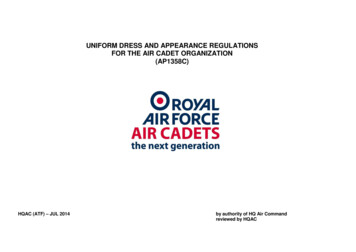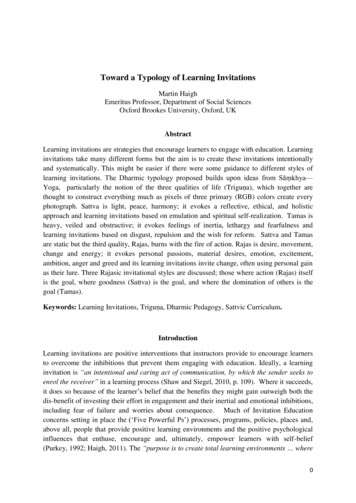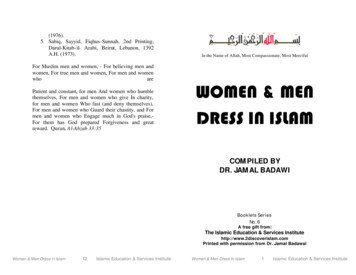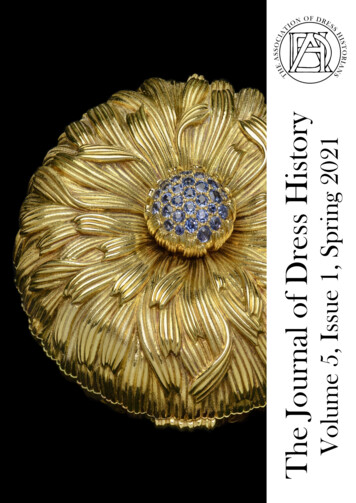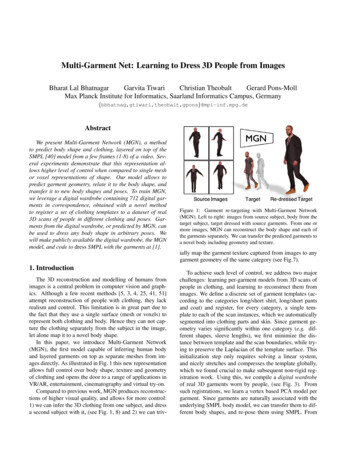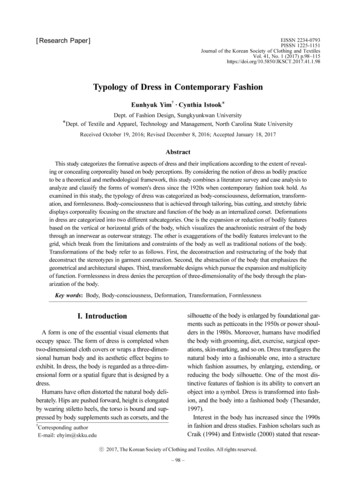
Transcription
[ Research Paper]EISSN 2234-0793PISSN 1225-1151Journal of the Korean Society of Clothing and TextilesVol. 41, No. 1 (2017) p.98 ogy of Dress in Contemporary Fashion†Eunhyuk Yim · Cynthia Istook*Dept. of Fashion Design, Sungkyunkwan University*Dept. of Textile and Apparel, Technology and Management, North Carolina State UniversityReceived October 19, 2016; Revised December 8, 2016; Accepted January 18, 2017AbstractThis study categorizes the formative aspects of dress and their implications according to the extent of revealing or concealing corporeality based on body perceptions. By considering the notion of dress as bodily practiceto be a theoretical and methodological framework, this study combines a literature survey and case analysis toanalyze and classify the forms of women's dress since the 1920s when contemporary fashion took hold. Asexamined in this study, the typology of dress was categorized as body-consciousness, deformation, transformation, and formlessness. Body-consciousness that is achieved through tailoring, bias cutting, and stretchy fabricdisplays corporeality focusing on the structure and function of the body as an internalized corset. Deformationsin dress are categorized into two different subcategories. One is the expansion or reduction of bodily featuresbased on the vertical or horizontal grids of the body, which visualizes the anachronistic restraint of the bodythrough an innerwear as outerwear strategy. The other is exaggerations of the bodily features irrelevant to thegrid, which break from the limitations and constraints of the body as well as traditional notions of the body.Transformations of the body refer to as follows. First, the deconstruction and restructuring of the body thatdeconstruct the stereotypes in garment construction. Second, the abstraction of the body that emphasizes thegeometrical and architectural shapes. Third, transformable designs which pursue the expansion and multiplicityof function. Formlessness in dress denies the perception of three-dimensionality of the body through the planarization of the body.Key words: Body, Body-consciousness, Deformation, Transformation, Formlessnesssilhouette of the body is enlarged by foundational garments such as petticoats in the 1950s or power shoulders in the 1980s. Moreover, humans have modifiedthe body with grooming, diet, exercise, surgical operations, skin-marking, and so on. Dress transfigures thenatural body into a fashionable one, into a structurewhich fashion assumes, by enlarging, extending, orreducing the body silhouette. One of the most distinctive features of fashion is its ability to convert anobject into a symbol. Dress is transformed into fashion, and the body into a fashioned body (Thesander,1997).Interest in the body has increased since the 1990sin fashion and dress studies. Fashion scholars such asCraik (1994) and Entwistle (2000) stated that resear-I. IntroductionA form is one of the essential visual elements thatoccupy space. The form of dress is completed whentwo-dimensional cloth covers or wraps a three-dimensional human body and its aesthetic effect begins toexhibit. In dress, the body is regarded as a three-dimensional form or a spatial figure that is designed by adress.Humans have often distorted the natural body deliberately. Hips are pushed forward, height is elongatedby wearing stiletto heels, the torso is bound and suppressed by body supplements such as corsets, and the†Corresponding authorE-mail: ehyim@skku.edu 2017, The Korean Society of Clothing and Textiles. All rights reserved.– 98 –
Typology of Dress in Contemporary Fashionchers in dress should incorporate the body in analyzing dress. The growing interest in the body was alsoacknowledged in exhibitions such as Reveal or Conceal? (Feb. 2008 - Jan. 2009, McCord Museum ofCanadian History, Montreal) which won the RichardMartin Exhibition Award at the Costume Society ofAmerica in 2009 and Skin Bones: Parallel Practicein Fashion and Architecture (Nov. 2006 - Mar. 2007,Museum of Contemporary Art (MOCA), Los Angeles / Jun. 2007 - Aug. 2007, The National Art Center,Tokyo / Apr. 2008 - Aug. 2008, Somerset House, London) which paid attention to the interchanges betweenfashion and architecture.In this study, we intend to examine the formativeaspects of dress drawing on the perception of the body;we attempt to categorize forms of dress according tothe extent of revealing or concealing corporeality. Thisstudy classifies and analyzes formative characteristicsof dress, in other words, suggests a typology of dress,of contemporary fashion design. Furthermore, thisstudy examines implications in each category of theformative aspect by focusing on the relationship between the body and dress, which establishes a framework for analyzing forms and images of existing aswell as emerging forms of dress.As a seminal example of previous studies, DeLong(1998) developed models that consider the role of thebody in the presentation of appearance to assess observer's aesthetic responses. Analyzing dress formsfrom a cognitive point of view, her Apparel-Body-Construct (ABC) model acknowledged the processes through which observers perceive, understand, and organize the clothed appearance of humans. This model'sfive categories – closed/open, part/whole, planar separation/integration, flat/rounded, and determinate/indeterminate – are based on Heinrich Wölfflin's fivesets of polarities in his art theory.Instead of categorizing with sets of polarities, thisstudy attempts to build a framework that categorizesthe formative aspects of dress according to the degreeof conformity/disconformity to the conventional Western sartorial representations. Moreover, as a significant number of fashion designers have been challenging Western tailoring practices as well as deconstructing Western sartorial conventions since the 1980sand more commonly since the 1990s, the need to categorize and analyze those contemporary fashion designs arises. This study examines how contemporaryfashion designs disconform to or challenge the dominant aesthetics of Western fashion via the manipulation of the body-dress relationship.The research contributes to lending structure to theformative aspects of dress otherwise ambiguous parameters related to body-dress in fashion design, by structuring as follows: the first section presents the theoretical reviews of dress as corporal space in contemporary fashion, while the second section discusses howa typology of dress can be developed giving special attention to the interplay between the body and dress.Finally, the implications of each category of the typology are discussed in terms of the relationship betweenthe body and dress.This study combines literature survey and case analysis in order to analyze and classify the forms of women's dress since the 1990s by examining the literature of fashion studies and dress history as well as photographs from Haute Couture and Prêt-à-Porter collections. This study deals principally with the end ofthe twentieth century and the new millennium to makethe content engaging through relevance and currency.II. Literature Reviewson the Body and DressThe body and dress are in a dialectical relationship.While dress manipulates the phenomenological body, body as a dynamic site animates dress (Entwistle,2002). Dress is not formed irrelevant to body shapebut follows the design laws that are intimately associated with the body.In the human body as a spatial form, the skin represents the border between interior and exterior space.As such, a dress is regarded as an extension of theboundary of ‘corporal space’ (Loschek, 2009), not tomention space where the corporal space and environment interact. As dress always refers or indicates thebody, it is considered to symbolize a body form. According to Loschek (2009), both a dress form and adisplay mannequin function as a representative of thehuman body form. She describes a mannequin as an– 99 –
Journal of the Korean Society of Clothing and Textilesideal living body at the interface between the inanimate dress form and the imperfect body of a wearer.Perception of the body as a spatial form has beenapparent throughout the history of dress. Dress notonly deals with a spatial figure of the body but limits orexpands a body form. In this regard, Loscheck (2009)states that dress points to a basic model that is ‘bothplastic and sculptural’; fabric drapes around the body(plastic) and the fabric is cut out and sewn together (sculptural). Furthermore, dress is the interface betweencreation and social communication, as well as between form and media.Throughout history, with its intimate relationshipto dress, the body has appeared as a malleable form,often surrendering to the extreme vision of beauty pulled in, padded out, tightened, or extended in analmost unimaginable way. Exaggerating body forms such as padding or tightening the torso, filling upskirts with devices such as hoops and cages, and modifying the body contour with wires, wood, and whalebones have been used in Western dress in order toreduce or expand the visual field of the body. Fashionable dress has manipulated the physical structureof the body by methods that are sometimes mortallyharmful. Fashion has continuously attempted to create/re-create its shifting image of beauty on the canvas of the human body (de Perthuis, 2008).For Are Clothes Modern? , an exhibition held atThe Museum of Modern Art in New York in 1944,Rudofsky (1984) designed four different plaster figures, representing a bustle of the 1870s, a monobosom of 1904, a hobble skirt of 1913, and a flapper dressin the 1920s. Each figure corresponds to the form ofdress from different periods (Fig. 1). As such, interference to human anatomy has been made with devicessuch as bustles, pads, heels, codpieces, and brassieres,for mere deception or bodily deformation. To look fashionable, humans have conformed to constantly changing corporeal ideals. Although the parts of the bodywhich each period or culture focuses on might differ,fashionable dress continuously has been manipulatingproportions of the body by applying elements that areoften even contrary to an actual body proportion. Moreover, people now modify the body with various activities such as diet, exercise, and plastic surgery.Vol. 41 No. 1, 2017Fig. 1. Plaster figures by Rudofskyfor Are clothes modern? .From Rudofsky. (1984). pp. 122 123.As Arnheim (1969/1981) explains, there is a relationship between a visual image and the content itattempts to hold. Images of a human body can be integrated into a few elements and in a similar vein theconventional forms of dress can be represented in several elements. The organic unity of the body is reconstructed according to the knowledge regarding theobject; the permissible range depends on the styles ofthe time. As such, the elongated female figures in fashion magazines appear to be normal to observers sincesuch figures are perceived as the idealized look.On the other hand, many postmodern fashion designers deconstruct a dressed body or playfully manipulate Western tailoring practices by draping in a waythat does not conform to Western sartorial conventions. For example, Rei Kawakubo often presents ambiguous body contours while Vivien Westwood unconventionally exaggerates body curves with tailoring.As a result, strong tension is displayed since there isbarely any relationship between the pattern that isbeing seen and the one that is supposed to be seen(Arnheim, 1969/1981).III. Typology of DressForm, one of the essential features that are detectedby the eyes, refers to the spatial aspect of an object tothe exclusion of position and direction. A form is thecontour of a mass and visualized by the two-dimensional face of a three-dimensional object (Arnheim,1969/1981). This study assumes the formative aspect– 100 –
Typology of Dress in Contemporary Fashionof dress as a referential frame and examines dressdrawing on the body that is perceived as the object ofgarment construction.Representation of the body in dress accompaniesthe comparison between an object and its representedimage. Since the image cannot be an exact copy of theobject, discrepancy always occurs. Thus, there existdistinctive features of dress that deviate from the exactrepresentation of the body.As people tend to pay attention to the parts that aredifferent from the whole (Arnheim, 1969/1981), fashion designs that deviate from body-conscious formthrough deforming, transforming, or totally eliminating/ignoring body forms, add tension. Some fashiondesigners idealize a female body as with tightly fittingdresses as Azzedine Alaïa or Hervé Léger do, whileother designers expand the corporal field with geometric structures as in the stair shaped Zig Zag orconcentric-circled Minaret dress by Issey Miyake.In this study, we categorize the formative aspectsof dress according to the ways that a space betweenthe body and dress is formed in conjunction with theextent of revealing or concealing corporeality. Thebody in this study is referred to or defined as the idealized body in Western convention that is sartoriallyembodied as the typical body-conscious dress. Thebody-conscious dress conforms to the conventionalbody image which often reveals or articulates theideal body; whereas to disconform the conventionsboth corporeally and sartorially, designers frequentlyconceal or deconstruct the idealized body or sartorialconventions. In this study, the formative aspects ofdress will be classified into the following four categories: body-consciousness, deformation, transformation, and formlessness.ents embodies the ultimate proximity between representation and visual concept of the body and is bestexemplified by minimally tailored designs, body-hugging bias-cut dresses, and form-fitting garments instretch fabrics.Christopher Breward explained that the new tailoring techniques which have appeared since the 1820s such as the development of measuring and cuttingdevices, as well as the invention of the tape measure are closely related to the appearance of women's bodies in public space (Entwistle, 2002). The tailoringtechnique, a practice that is performed most intimatelyand closely to the body, visualizes cultural attitudes.In Western dress, interfacing and padding were usedto idealize a body image, with the perception of anideal anatomy being modified continuously. While anideal silhouette changes constantly, the notion of a tailored suit as a hollow casting has not been challenged(Rudofsky, 1984). When a wearer takes off a tailoredgarment, it is supposed to be best kept on a dress formin order to maintain its shape.Gilbert Adrian and Lachasse Ltd. – designers wellknown for their classic and angled shoulders basedon controlled lines of menswear – redefined the notionof decoration with measured cutting, matching, mitering, and exquisite sewing (Spilker & Takeda, 2007).Each panel of a jacket is discreetly cut, matched, andsewn, so as to represents the ideal female body curvesof the time. Hervé Léger and Azzedine Alaïa, on theother hand, romantically visualized a female body byhorizontally wrapping the body with stretch strips ofknitted fabric, not with restrictive corset fabrics (Fig.2).At the core of these minimally tailored designs,there is a connection to the principles of modernarchitecture. In other words, these designers embodylines and structural seams of garments through anarchitectural approach and, with those seams andconstruction lines, show how pattern pieces are to becombined. The architectural or structural approach which aims for a body-conscious form of dress reflectsthe adage ‘form follows function’ by Ludwig Mies vander Rhoe, a Bauhaus architect (Hodge et al., 2006). Asa result, garments are constructed without decorationwhich is unrelated to the structure; the seams and darts1. Body-consciousnessThe most generally and naturally accepted dress silhouette is the body-conscious form which enables usto perceive a body shape. Among the forms of the contemporary dress after WW I, the most common formof dress, except for some Haute Couture pieces andexperimental designs, is in silhouettes without significant adjustments to body contour. This type of garm-– 101 –
Journal of the Korean Society of Clothing and TextilesFig. 2. Azzedine Alaïa,1990.From Eastoeand Gristwood.(2009). p. 47.Vol. 41 No. 1, 2017wrapping rather than cutting fabric.As examined so far, for the body-conscious dress,tailored pattern pieces are cut from a length of fabricand stitched together into a three-dimensional formthat encloses the body, or fabric is draped around thebody and then trimmed in such a way. In both techniques, the result is a garment people usually wear asa casing for the body (Brand et al., 2010). Aside fromtailoring and draping, the body-conscious form ofdress can be constructed through the physical properties of a fabric itself. When a garment is worn on thebody, continuous circulations of interchange betweenvoid and mass are made. Elastic fabrics, such as Lycra,Tactel, and Latex, cling to the body and reduce thevoid between the body and a garment. The elasticfabrics encase the body as ‘the second skin’. The keyfeature of the second skin is to embody a vision inwhich a synthetic fabric similar to human skin is integrated into the skin. Today new types of fabrics alreadyreact to heat, light, touch, and mechanical strain. Skinthetic by KnoWear is a hybrid material with flexiblemembranes that are capable of being digitally networked, folded, stretched, or inflated with air to create a second skin in place of clothes made of fabrics(Seltmann & Lippert, 2006).In regard to implications, even in the body-conscious dress which reveals the body at it is, the body represented is a culturally idealized one. That is, in contemporary society, where a corset is not worn anymoreto modify the body shape, the body itself performs as‘invisible corset’ (The Kyoto Costume Institute, 1999)or ‘muscular corset’ (Steele, 2001). In other words, fashion after the twentieth century has changed ‘fromclothing-fashion to body-fashion’ (Brattig, 2003). Women are freed from corset made of wires and whalebones but controlled by a new form of corset called amuscular body. Power in contemporary society covertly stimulates desire rather than oppressively dominates, so that women voluntarily conform to the power and are controlled by the consciousness that theyshould cultivate their body without a corset.Since the premise of wearing a body-revealing dressis having an idealized body, in order to wear a bodyconscious dress one should be wearing an invisiblecorset of a muscular body. In this regard, the corset hasFig. 3. Calvin Klein,2008.From Phelps.(2007).http://www.vogue.comthemselves function as decoration. These body-conscious forms of dress are presented close to the bodyby minimizing the space between the body and a garment, as opposed to being independent to silhouettesof the body.Besides the architectural constructions stated above,body-conscious silhouettes are effectively realized through bias cutting. Bias cutting reveals the body in asimilar manner to tailoring, but bias cutting spiralsaround the body freed from the vertical or horizontalgrids of the body. While cutting on a lengthwise grainis more stable in general, bias cutting gives more elasticity, which keeps a dress close to the contour of thebody (Fig. 3).Madeleine Vionnet, a master of bias cutting, freeddress from limits of vertical and horizontal axes. Moldable silhouettes of Vionnet's dress react to movements of the body while spiraling around the body. Itcould be said that whereas Cristobal Balenciaga centralized presence of fabric in tailoring, Vionnet mastered handling gravity in dressmaking. In a similarvein, Madame Grès preferred simplicity that was realized through draping the body smoothly, not by restricting the body with artificial devices such as a corset or padding. Grès shaped dress through draping or– 102 –
Typology of Dress in Contemporary Fashionnot disappeared but has been internalized in a sculptedbody. In a body-conscious garment that reveals thebody at it is, the actual object of representation is notan individual body but a corporeal ideal that a societyof the time culturally idealizes.nine body parts.In Western fashion, the body has been idealized andsublimated through elaborate tailoring techniques.One of the basic forms of this idealization is symmetry, which has been regarded as a standard of beauty;symmetrical lacing and padding as devices of thisidealization standardize and eroticize the body. Anhourglass body shape as an erotic ideal has been realized by artificial apparatuses such as push-up brassieres, corsets, and bodices to flatten the thorax or elevate the breasts and hips. Whichever part of the bodyis exaggerated, whether such exaggeration looks artificial or natural, the body has been strictly shapedsymmetrically (Fukai et al., 2010).However, in contemporary fashion, the deformationin dress is often interpreted in a different context fromthe traditional one, as such bodily manipulation hasbeen internalized in the twentieth century. The deformation in contemporary fashion intentionally digresses from the conventional sartorial association between signifier and signified by visualizing the deformation in an anachronistic way. Alexander McQueenand Hussein Chalayan, for example, introduced thecorset in a grotesque and parodic way to representphysical damage or deformity caused by the restriction of a female body (Fig. 4) (Fig. 5). Naoki Takizawa for Issey Miyake manipulated interior space of agarment by constructing a tailored suit with muscleshaped inflatable panels; a natural female body iscompletely concealed behind the inflated bodice of2. DeformationDeformation, one of the incentives for three-dimensional perception, is a type of deviation that breaksaway from an expected position (Arnheim, 1969/1981).The silhouette of dress that assumes deformation deviates from physical margins of a body structure, whichbuilds up tension. In Western fashion, one of the fundamental elements of the idealized beauty has beensymmetry. For this category, we classified deformation of dress into two sub-categories according to thecompliance of the vertical/horizontal axes of the bodywhich is regarded as a basic condition of the symmetry; 1) symmetrical deformation which suggests enlargement or reduction based on the vertical/horizontalaxes of the body and 2) asymmetrical deformationwhich explains enlargement or reduction irrelevantto bodily axes.1) Symmetrical Deformation: Enlargement orReduction based on Vertical/Horizontal Axesof the BodyDeformation through enlargement or reduction in atraditional Western dress appears predominantly symmetrical paralleling to the vertical/horizontal axes ofthe body; this type of deformation in dress enlarges orreduces certain body parts symmetrically. The deformation is interpreted as a representation of meaningsand symbols of the body through dress-as-signifier. Inother words, the deformation in dress signifies femininity, fertility, inaccessibility, or wealth and status(Koda, 2001; Laver, 2002), to meet the aesthetic demands of the times. The body has been deformed through dress in order to be fitted to cultural frames whichthe body could hardly assimilate to. In an effort tomake the neck longer, the shoulders wider, the breastslarger or smaller, and the hips larger, dress has beenused to deform the body, which is in close association with cultural perception of corresponding femi-Fig. 4. HusseinChalyan, Surgicalcorset, 1998.From Steele.(2001). p. 174.– 103 –Fig. 5. AlexanderMcQueen,1999.From Gleason.(2012). p. 58.
Journal of the Korean Society of Clothing and Textilesthe exaggeratedly idealized muscular body shape.On the other hand, Jean Paul Gaultier and VivienneWestwood, designers who are known for collectionsdrawing on historical costumes, employed the corsetas a decorative item in an underwear-as-outerwearmanner. These designers incorporated the erotic auraof a corset as a device to satire conformity to the aesthetic standard of society.Vol. 41 No. 1, 2017deformation, Noa Raviv worked on 3D software andthen translated the patterns into fabrics by printing andstitching the lines and grids onto fabrics. The gridlike patterns in ribbed layers of polymer were warpedand stretched across the garments, which creates optical illusions across the body. Raviv has deliberatelymanipulated digital images with computer modelingsoftware to deform the traditional versions of bodices. In an interview (Howarth, 2014), Raviv said thatshe used the shapes of broken Greek and Roman marble sculptures to inform the asymmetric silhouettes.She mentioned that patterns of the collection weremostly nonsymmetrical to enhance distorted or fractured looks.In a similar vein, Finnish designer Minna Palmqvist,through her Intimately Social series, has depictedthe coerciveness of the ideals of feminine beauty andits distantness from reality. Palmqvist explores thestruggle between the socially accepted female bodyand the real bodies, in other words, a conflict amongwhat is forced upon us, what we wish for, and whatwe strive to hide (Palmqvist, 2009) which often results in asymmetric forms and shapes (Fig. 8).These asymmetrical deformations do not intend toemphasize femininity in an attempt to supplementbody defect or exaggerate feminine beauty as in tradi-2) Asymmetrical Deformation: Enlargement orReduction Irrelevant to Bodily AxesIn contemporary fashion, deformation in dress sometimes appears irrelevant to historical reference of traditional dress. These deformations in dress exaggerate a body shape irregularly and asymmetrically bydeliberately breaking from vertical or horizontal axesof the body. Designs of Rei Kawakubo are representative cases of asymmetrical deformation in dress. In hercollection, Body meets dress, body becomes dress,dress becomes body , Kawakubo presented asymmetrical dresses which deviated from vertical/horizontalgrids of the body far exceeding the limits of what isconsidered to be a good taste of the time (Fig. 6). Onthe so-called ‘lumps and bumps’ dress from the collection, the emphasis of feminine curves is shifted tounusual places such as the back or abdomen, awayfrom traditionally emphasized body parts, which couldbe regarded as an attack on the symmetry of Westernfashion. Kawakubo propounds a question of the physical ideal by showing that lines of demarcation between ideal and deformity are a matter of a few inchesin a garment. Through the collection, she suggestedthat the interesting sculptural effect created by unexpected volumes may be seen as repellent since theyare associated with ‘deformity’ (Teunissen et al., 2014).By departing radically from the socially accepted anatomical form, Rei Kawakubo undermines the Western femininity and ideals of beauty. Her designs havebeen depicting her criticism on the feminine beautyin established fashion. In this regard, Teunissen et al.(2014) argues that Body meets dress questions whether symmetry is a necessary ingredient of beauty.Fashion designer Noa Raviv integrated 3D-printeddesign elements into ruffled dresses done by distorteddigital drawings (Fig. 7). In order to evoke images ofFig. 6. ReiKawakubo, Body meetsdress , 1997.From In pictures:30 years of Japanesefashion. (2010).http://www.bbc.co.uk– 104 –Fig. 7. Noa Raviv,2014.From Noa Ravivuses 3D printed polymersfor virtual realityfashion collection.(2014).http://www.designboom.com
Typology of Dress in Contemporary Fashionstructures, 2) abstraction that radically digresses frombody structures and silhouettes, and 3) transformableswhich aims for multifunction in dress. As we postulate a basic body-conscious dress as the ideal body inthat its dress parts correspond to the respective bodyparts, deconstruction disintegrates and reconstructsthe conventional body-garment correspondence, abstraction exceeds the conventional body-garment space,and transformables expand beyond the conventionalbody-garment functions.1) DeconstructionThe term ‘deconstruction’ (Hodge et al., 2006) hasbeen applied to areas such as art, architecture, design,and music for more than thirty years. Deconstructionin fashion challenges the foundations of the sartorialconvention; its implications radically deviate from thesophisticated and elaborately finished dress that dominated the 1970s and 1980s.Deconstructed garments often appear unfinishedwith details such as frayed or worn out hems; sometimes look fragmented, recycled, or recombined. Deconstructed fashion design is dominantly in dark toneswhich frequently suggest poverty, deconstruction, anddegradation. The deconstructed garments lack clearfrontality, and the silhouettes do not reveal body contours.When introduced in the early 1980s in fashion, aesthetics of deconstruction were rejected in the initialstage; however, it went through turnabout in the 1990swhilst being rapidly appropriated by mainstream andhigh fashion. While deconstruction in dress was originated from the countercultural movements of Punksin the 1970s, its appearance in the early 1980s runwayshows of Comme des Garçons and Yohji Yamamotoare regarded as the official introduction to high fashion (Hodge et al., 2006). Subsequently, Belgian designers such as Ann Demeulemeester, Dries Van Noten,and Martin Margiela presented new types of deconstruction fashion in the late 1980s.Margiela, notably, challenged the fastidious standards of Haute Couture and overturned traditional elements of techniques of tailors and dressmakers. Although, in general, linings, shoulder pads, interfacings,and facings are concealed carefully, Margiela utilizedFig. 8. Minna Palmqvist, Intimately Social, 2011.From Batsis. (2011). http://stretchgenerics-ab.blogspot.comtional Western dress, on the contrary, they seek to depart from the traditional notio
aspects of dress drawing on the perception of the body; we attempt to categorize forms of dress according to the extent of revealing or concealing corporeality. This study classifies and analyzes formative characteristics of dress, in other words, suggests a typology of dress, of contemporary fashion design. Furthermore, this
